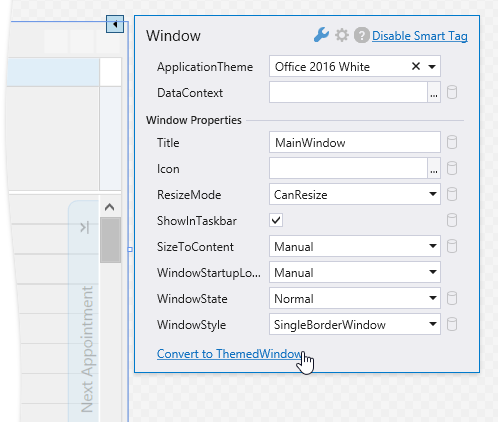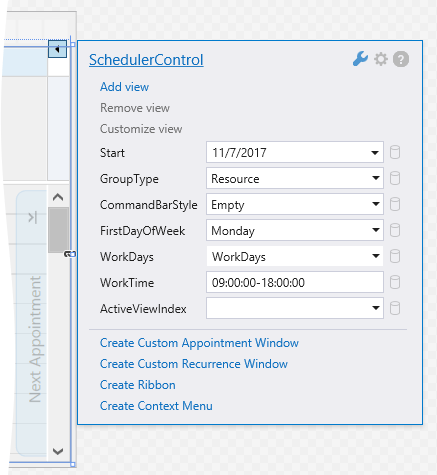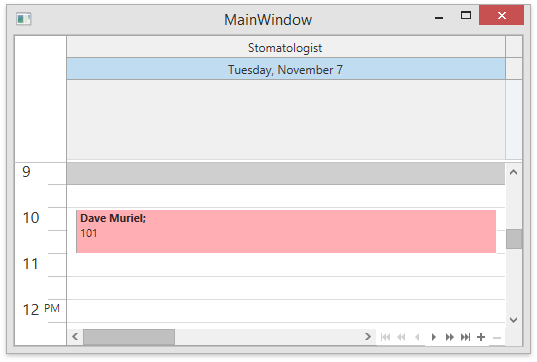Create a Simple Scheduling Application
- 6 minutes to read
This document provides instructions on how to create a simple scheduling application with the SchedulerControl.
Create a New Project
- Create a new WPF Application project, name it SimpleSchedulingExample and open the MainWindow.xaml file in the Visual Studio Designer.
Add the SchedulerControl object to your project. You can do this by dragging the SchedulerControl item from the DX.19.1: Scheduling Toolbox tab to the canvas.

- Right-click the SchedulerControl object and select Layout | Reset All in the context menu to stretch the SchedulerControl so that it fills the entire window.
Apply Theme
For visual consistency, convert the main window to the ThemedWindow…:

… and change the application theme to the Office 2016 Colorful theme.
Create a Data Model
We use DevExpress MVVM Framework to create a POCO ViewModel that provides data for an application.
The MedicalAppointment class instance is an Appointment:
public class MedicalAppointment {
public static MedicalAppointment Create() {
return ViewModelSource.Create(() => new MedicalAppointment());
}
internal static MedicalAppointment Create(DateTime startTime, DateTime endTime,
int doctorId, string notes, string location, int categoryId, string patientName,
string insuranceNumber, bool firstVisit) {
MedicalAppointment apt = MedicalAppointment.Create();
apt.StartTime = startTime;
apt.EndTime = endTime;
apt.DoctorId = doctorId;
apt.Notes = notes;
apt.Location = location;
apt.CategoryId = categoryId;
apt.PatientName = patientName;
apt.InsuranceNumber = insuranceNumber;
apt.FirstVisit = firstVisit;
return apt;
}
protected MedicalAppointment() { }
public virtual int Id { get; set; }
public virtual bool AllDay { get; set; }
public virtual DateTime StartTime { get; set; }
public virtual DateTime EndTime { get; set; }
public virtual string PatientName { get; set; }
public virtual string Notes { get; set; }
public virtual string Subject { get; set; }
public virtual int StatusId { get; set; }
public virtual int CategoryId { get; set; }
public virtual int Type { get; set; }
public virtual string Location { get; set; }
public virtual string RecurrenceInfo { get; set; }
public virtual string ReminderInfo { get; set; }
public virtual int? DoctorId { get; set; }
public virtual string InsuranceNumber { get; set; }
public virtual bool FirstVisit { get; set; }
}
The Doctor class instance is a resource:
public class Doctor {
public static Doctor Create() {
return ViewModelSource.Create(() => new Doctor());
}
public static Doctor Create(int Id, string Name) {
Doctor doctor = Doctor.Create();
doctor.Id = Id;
doctor.Name = Name;
return doctor;
}
protected Doctor() { }
public virtual int Id { get; set; }
public virtual string Name { get; set; }
}
Create a View Model
Create a view model that exposes two ObservableCollection type collections which are used for data binding.
using System;
using System.Collections.ObjectModel;
namespace SimpleSchedulingExample {
public class MainViewModel {
public virtual ObservableCollection<Doctor> Doctors { get; set; }
public virtual ObservableCollection<MedicalAppointment> Appointments { get; set; }
protected MainViewModel() {
CreateDoctors();
CreateMedicalAppointments();
}
private void CreateDoctors() {
Doctors = new ObservableCollection<Doctor>();
Doctors.Add(Doctor.Create(Id: 1, Name: "Stomatologist"));
Doctors.Add(Doctor.Create(Id: 2, Name: "Ophthalmologist"));
Doctors.Add(Doctor.Create(Id: 3, Name: "Surgeon"));
}
private void CreateMedicalAppointments() {
Appointments = new ObservableCollection<MedicalAppointment>();
Appointments.Add(MedicalAppointment.Create(
startTime: DateTime.Now.Date.AddHours(10), endTime: DateTime.Now.Date.AddHours(11),
doctorId: 1, notes: "", location: "101", categoryId:1, patientName: "Dave Muriel",
insuranceNumber: "396-36-XXXX", firstVisit: true));
}
}
}
Set the DataContext of the MainWindow to the MainViewModel instance:
xmlns:dxmvvm="http://schemas.devexpress.com/winfx/2008/xaml/mvvm"
DataContext="{dxmvvm:ViewModelSource local:MainViewModel}"
Provide Initial Settings
Use the SchedulerControl’s Smart Tag to specify SchedulerControl properties: set the SchedulerControl.GroupType property to SchedulerGroupType.Resource to group the view by resources, and set the SchedulerControl.FirstDayOfWeek property to FirstDayOfWeek.Monday so that Monday starts the Week View and Work Week View displays.

<dxsch:SchedulerControl GroupType="Resource" FirstDayOfWeek="Monday" />
Tip
All view types with default settings are available “out-of-the-box”. However, you can create any number of views with different types and settings. See the Manage Views section for more information.
Bind to Data
Bind the DataContext collections to the DataSource.AppointmentsSource (for MedicalAppointment objects) and DataSource.ResourcesSource (for Doctor objects) properties. Appointment and resource properties should be mapped to the MedicalAppointment and Doctor class properties, respectively. Specify mappings using the DataSource.AppointmentMappings and DataSource.ResourceMappings properties.
Note
A complete sample project is available at https://github.com/DevExpress-Examples/how-to-create-a-simple-scheduling-application-t545377.
<dxsch:SchedulerControl.DataSource>
<dxsch:DataSource AppointmentsSource="{Binding Appointments}" ResourcesSource="{Binding Doctors}">
<dxsch:DataSource.AppointmentMappings>
<dxsch:AppointmentMappings AllDay="AllDay"
Description="Notes"
End="EndTime"
Id="Id"
LabelId="CategoryId"
Location="Location"
RecurrenceInfo="RecurrenceInfo"
Reminder="ReminderInfo"
ResourceId="DoctorId"
Start="StartTime"
StatusId="StatusId"
Subject="PatientName"
Type="Type">
<dxsch:CustomFieldMapping Mapping="InsuranceNumber" Name="InsuranceNumber" />
<dxsch:CustomFieldMapping Mapping="FirstVisit" Name="FirstVisit" />
</dxsch:AppointmentMappings>
</dxsch:DataSource.AppointmentMappings>
<dxsch:DataSource.ResourceMappings>
<dxsch:ResourceMappings Caption="Name" Id="Id" />
</dxsch:DataSource.ResourceMappings>
</dxsch:DataSource>
</dxsch:SchedulerControl.DataSource>
Run the Project

Double-click an appointment to edit it, right-click an appointment to change its label or status, or select a time cell and start typing to create a new appointment with the specified subject.
Next Steps
You can create and modify appointment, adjust the layout and switch views. However, appointments do not persist after closing the application because the Scheduler control operates in unbound mode. To save changes, bind the Scheduler to an external data source as illustrated in the How to: Bind Scheduler to Data using the Entity Framework Code First Approach example.
The Scheduler control has the necessary windows and dialogs available out-of-the-box. You can use the approach illustrated in the How to: Customize Editing and Recurrence Dialogs example to change them or modify the template as shown in the How to: Customize the In-Place Editor example.
Learn more at the Examples section.